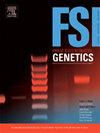韩国人年龄预测的VISAGE增强工具的独立验证和平台转换分析
IF 3.1
2区 医学
Q2 GENETICS & HEREDITY
引用次数: 0
摘要
基于DNA甲基化的年龄预测正在成为法医遗传学的一个关键课题,为刑事调查提供重要信息。总部位于欧洲的VISAGE基因组学可见属性(VISAGE)联盟最近报告了一系列年龄预测模型,该模型使用大规模平行测序(MPS)方法分析血液、口腔细胞和骨骼DNA,显示出较高的预测精度,平均绝对误差(MAE)小于4年。为了探索人群特异性差异,我们使用来自韩国人的300份血液和150份颊细胞DNA样本复制了基于VISAGE mps的分析。由于VISAGE模型的方程没有公开可用,我们在相同的CpG位点使用多元线性回归构建了新的模型。尽管年龄相关CpG标记的排名存在差异,但我们新开发的韩国人血液年龄模型显示出与VISAGE血液模型(MAE为3.2年)相当的MAE(3.4年),而我们的颊细胞模型显示出与VISAGE颊细胞模型(MAE为3.7年)相比稍高的MAE(4.3年)。此外,为了促进更广泛的跨平台应用,我们使用SBE方法开发了其他模型,并与MPS方法获得的甲基化水平进行了比较分析。该比较显示,在VISAGE血液和颊细胞模型中,所有CpG位点的甲基化水平在平台间存在显著差异(p值<;0.05)。为了解决这一问题,我们开发了独立于平台的模型,通过使用11种具有不同甲基化比率(0 %-100 %)的对照dna校准甲基化水平。尽管校准后的数据在不同平台间仍显示出统计学上的显著差异,但与平台无关的血液模型获得了较高的预测精度,MAE为3.6年。然而,颊细胞模型精度较低,且仍存在平台间差异,表明CpG位点对校准方法的影响不同。此外,我们利用各种回归方法对韩国MPS数据集优化了韩国人的年龄预测模型。血液和颊细胞模型均具有较高的年龄预测准确性,MAEs分别低于3.4岁和4.2岁。总之,我们的研究强调了在开发可靠的基于DNA甲基化的法医模型时考虑生物学和技术因素的重要性。本文章由计算机程序翻译,如有差异,请以英文原文为准。
Independent validation of the VISAGE enhanced tool for age prediction in Koreans and analysis of platform transition
Age prediction based on DNA methylation is emerging as a pivotal topic in forensic genetics, providing crucial information for criminal investigations. The Europe-based VISible Attributes Through GEnomics (VISAGE) Consortium recently reported a series of age prediction models by analyzing blood, buccal cells, and bone DNA using the Massively Parallel Sequencing (MPS) method, demonstrating high prediction accuracy with Mean Absolute Errors (MAE) of less than 4 years. To explore population-specific differences, we replicated the VISAGE MPS-based analysis using 300 blood and 150 buccal cell DNA samples from Korean individuals. Since the VISAGE models' equations are not publicly available, we constructed new models using multiple linear regression at the same CpG sites. Despite differences in the ranking of age-correlated CpG markers, our newly developed blood age model for Koreans exhibited a comparable MAE (3.4 years) to the VISAGE blood model (MAE of 3.2 years), whereas our buccal cell model demonstrated a slightly higher MAE (4.3 years) compared to the VISAGE buccal cell model (MAE of 3.7 years). Furthermore, to facilitate broader application across platforms, we developed additional models using the SBE method and conducted a comparative analysis of methylation levels with those obtained by the MPS method. This comparison revealed significant inter-platform differences (p-value <0.05) in methylation levels across all CpG sites included in VISAGE blood and buccal cell models. To address this issue, we developed platform-independent models by calibrating methylation levels using 11 control DNAs with varying methylation ratios (0 %-100 %). Although the calibrated data still exhibited statistically significant differences between platforms, the platform-independent model for blood achieved high prediction accuracy, with an MAE of 3.6 years. However, the buccal cell model displayed lower accuracy and still showed inter-platform variations, indicating that the calibration method is affected differently by CpG sites. Additionally, we optimized age prediction models for Koreans by employing various regression methods to the Korean MPS dataset. Both blood and buccal cell models achieved high age prediction accuracies, with MAEs below 3.4 years and 4.2 years, respectively. In conclusion, our study underscores the importance of considering both biological and technical factors in developing reliable DNA methylation-based forensic models.
求助全文
通过发布文献求助,成功后即可免费获取论文全文。
去求助
来源期刊
CiteScore
7.50
自引率
32.30%
发文量
132
审稿时长
11.3 weeks
期刊介绍:
Forensic Science International: Genetics is the premier journal in the field of Forensic Genetics. This branch of Forensic Science can be defined as the application of genetics to human and non-human material (in the sense of a science with the purpose of studying inherited characteristics for the analysis of inter- and intra-specific variations in populations) for the resolution of legal conflicts.
The scope of the journal includes:
Forensic applications of human polymorphism.
Testing of paternity and other family relationships, immigration cases, typing of biological stains and tissues from criminal casework, identification of human remains by DNA testing methodologies.
Description of human polymorphisms of forensic interest, with special interest in DNA polymorphisms.
Autosomal DNA polymorphisms, mini- and microsatellites (or short tandem repeats, STRs), single nucleotide polymorphisms (SNPs), X and Y chromosome polymorphisms, mtDNA polymorphisms, and any other type of DNA variation with potential forensic applications.
Non-human DNA polymorphisms for crime scene investigation.
Population genetics of human polymorphisms of forensic interest.
Population data, especially from DNA polymorphisms of interest for the solution of forensic problems.
DNA typing methodologies and strategies.
Biostatistical methods in forensic genetics.
Evaluation of DNA evidence in forensic problems (such as paternity or immigration cases, criminal casework, identification), classical and new statistical approaches.
Standards in forensic genetics.
Recommendations of regulatory bodies concerning methods, markers, interpretation or strategies or proposals for procedural or technical standards.
Quality control.
Quality control and quality assurance strategies, proficiency testing for DNA typing methodologies.
Criminal DNA databases.
Technical, legal and statistical issues.
General ethical and legal issues related to forensic genetics.

 求助内容:
求助内容: 应助结果提醒方式:
应助结果提醒方式:


